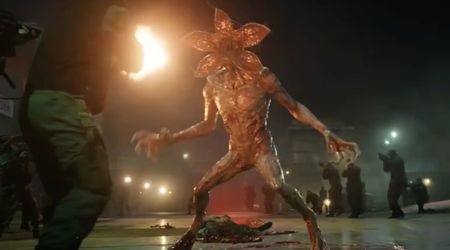'Alabama Snake' on HBO: Here's all you need to know on Appalachian snake-handling churches and their beliefs

In HBO's latest documentary, we learn an odd piece of history when a snake-handling preacher attempted to murder his wife using the snakes he kept on his property. On October 4, 1991, Darlene Summerford, was bitten twice on the hand by a rattlesnake or snakes, after her husband, Glenn Summerford forced her to stick her hand inside a cage of snakes. He accused her, falsely, she said, of running around on him with another preacher. Glenn, a pastor with the Church of Jesus With Signs Following in Scottsboro allegedly accused her of cheating on him.
The documentary also delves into a phenomenon many viewers may not have known existed in America -- churches that use serpents as part of their worship rituals. These rituals are especially popular in the Appalachian region, but how did it originate, are they legal and why do these snakes not seem to bite the preachers -- thereby seemingly proving that these preachers are "divine"?
How did it start?
It is believed that George Went Hensley began the 20th-century practice of snake handling during the summer of 1909 in a remote section of southeast Tennessee, later establishing the Church of God with Signs Following. His beliefs and practices spread to North Carolina and throughout the southern Appalachians, as well as to parts of the Midwest, where many unemployed mountain people had relocated to find jobs.
However, academic studies dispute that Hensley originated the practice and that claims of Hensley being the originator of snake-handling are usually found to be unsubstantiated by research, and the origins of the observance are unclear. Researchers also suggest that the beginnings of Pentecostal snake-handling rituals cannot be ascribed to a single person and that the observance arose independently on multiple occasions. However, they do agree that Hensley helped spread Pentecostal snake-handling throughout the southeast United States, and that coverage of Hensley's ministry was influential in prompting various churches to include the practice in their services.
What are their beliefs?
According to those who practice snake-handling, the handlers are possessed with the divine spirit's power. If one was bitten, they lack the true spirit. However, the congregation prays over them -- if they die, then God intended it to happen. Several Bible verses are used by snake handlers to validate their beliefs and practices, in particular Mark 16:17-18, which states, "And these signs shall follow them that believe; In my name shall they cast out devils; they shall speak with new tongues; They shall take up serpents; and if they drink any deadly thing, it shall not hurt them; they shall lay hands on the sick, and they shall recover." Snake handlers consider these words to be commands, not merely suggestions. They believe these words are binding to all who profess belief in the Gospels: God takes over their faculties, allowing them to carry out God's instructions without harm to themselves. For the Church of God with Signs, the belief is that snakes are incarnations of demons, so if a church member truly has the Holy Spirit within them, they should be able to handle venomous snakes – as well as drink poison and suffer no harm.
A typical service is pretty energetic, involving a lot of dancing, singing, preaching, and speaking in tongues. The snakes are kept behind the pulpit, and the species used ranges from rattlesnakes, cottonmouths, and copperheads, although cobras have been used. Church members can approach the snakes and pick them up to show their power over the demons. It is common to raise the serpents into the air, dance around with them, and even allow them to crawl on their body. If they choose to, church members can also engage in drinking poison, most commonly strychnine.
Why do the snakes not bite the handlers?
According to an NPR report, which featured opinions of snake experts, it is likely that a snake's reluctance to bite a religious serpent handler may have more to do with the creature's poor health than with supernatural intervention. "The animals that I've seen that have come from religious snake handlers were in bad condition," said Kristen Wiley to NPR. Wiley is the curator of the Kentucky Reptile Zoo, a facility in the town of Slade that produces venom and promotes the conservation of snakes. She continued, "They did not have water. The cages had been left not cleaned for a pretty long period of time. And the other thing we noticed is there were eight or 10 copperheads in a container that was not very large."
She also said there was no fecal material in the cages, indicating that the snakes were not being fed. Riley said a snake that may be dehydrated, underweight, and sick from close confinement is less likely to strike than a healthy snake. Moreover, the venom it produces is weaker. She added that snake-handling preachers who don't take care of their snakes are "setting themselves up for a safer encounter during their services when they use a snake that is in bad condition, to begin with."
Are snake-handling rituals legal?
Some states have adopted laws prohibiting the practice of snake handling or limiting it to trained individuals. No case on the practice has reached the Supreme Court. State courts have consistently upheld the state laws as reasonable health and safety regulations, such as the Court of Appeals of Kentucky in Lawson v. Commonwealth (1942) and the Alabama Court of Appeals in Hill v. State (1956). The Tennessee Supreme Court upheld a similar law in Harden v. State (1948). In Harden, the court cited the distinction that the U.S. Supreme Court had drawn in Davis v. Beason (1890), Reynolds v. United States (1879), and Cantwell v. Connecticut (1940), between the regulation of religious belief and action. The Tennessee Supreme Court adopted a similar ruling in Swann v. Pack (1975) when it upheld an injunction prohibiting members of a church from handling snakes and extended it to the drinking of strychnine.
'Alabama Snake' premieres on Wednesday, December 9, at 9/8c on HBO. The documentary will be available for viewing on HBO Max.










